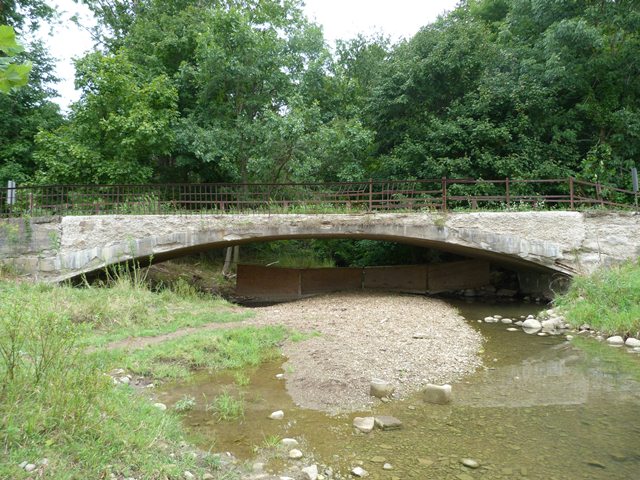We Recommend:
Bach Steel - Experts at historic truss bridge restoration.
Cooke Road Bridge
Gaddis Ford Bridge

Primary Photographer(s): Nathan Holth
Bridge Documented: August 12, 2012
Rural: Knox County, Ohio: United States
1896 By Builder/Contractor: Buckeye Portland Cement Company of Bellefontaine, Ohio and Engineer/Design: William H. Pratt
Not Available or Not Applicable
50.0 Feet (15.2 Meters)
52.2 Feet (15.9 Meters)
13 Feet (3.96 Meters)
1 Main Span(s)
4236580

View Information About HSR Ratings
Bridge Documentation
View Archived National Bridge Inventory Report - Has Additional Details and Evaluation
View Historic American Engineering Record (HAER) Documentation For This Bridge
HAER Data Pages, PDF
This small and unassuming bridge is one of the oldest concrete bridges in the country. With a Melan-style reinforcing system, it is also one of the rarest types of concrete arch bridge. The Melan system does not use rebar (reinforcing rods) to strengthen the concrete, but instead uses a steel arch embedded in concrete. In this case, the steel arch is created by use of bent railroad rails. The bridge retains original railings on one side only. The original railings are an unusual riveted metal fence style railing.
The bridge is a nationally significant historic bridge, yet is in a severely deteriorated condition. While bad for the bridge, the deterioration has exposed a section of the Melan style reinforcing, enabling photography of this normally hidden detail. It is hoped that this bridge will be restored.
Information and Findings From Ohio's Historic Bridge InventorySetting/Context The bridge carries a 1 lane road over a stream in a rural area of active farms. Physical Description The 1 span, 52'-long and 15'-wide concrete arch bridge uses bent 52-pound rail placed on 2' centers as the reinforcing, in imitation of the Melan system. The flat, thin shape of the arch was preferred by the fabricator. The bridge is finished with wrought iron railings set atop the curbs. The railings have impact damage. There is considerable spalling of the cement past leaving exposed and lost aggregate, but only limited exposed reinforcing. Integrity Significant loss of original fabric from deterioration, but there appears to be sufficient cover material to have protected the steel beams. The iron railings are original. Summary of Significance The 1896 steel and concrete arch bridge was built by the Buckeye Portland Cement Co. (est. 1888), the first Portland cement maker in the state, and is very much in the tradition of the Melan-type arch rather than
the design using reinforcing bars that came to dominate the bridge type early in the 20th century. Here 56-pound rails are bent into the elongated elliptical shape and placed on 2' centers to provide the reinforcing, then packed
with Buckeye's Portland cement to provide cover material for the steel. This short version of a Melan arch was designed by William H. Pratt (1852-1900) who was the general manager of the Mount Vernon Bridge Company from 1888 until
1898. He was also an early proponent of monolithic concrete bridges (as opposed to stone). Under his leadership, the company grew into a prominent national fabricator of metal bridges. A native of Vermont, he married Elizabeth Devin
of Mount Vernon woman and is buried locally. This bridge represents the era of experimentation that surrounded the introduction of "armed" concrete in this country. The bridge is the second oldest example of a "reinforced concrete"
arch in the state. Justification The bridge is one of the earliest "reinforced concrete" bridges in the country. It has national significance. It merits extraordinary measures and consideration for its preservation. Bridge Considered Historic By Survey: Yes |
![]()
Photo Galleries and Videos: Cooke Road Bridge
Bridge Photo-Documentation
Original / Full Size PhotosA collection of overview and detail photos. This gallery offers photos in the highest available resolution and file size in a touch-friendly popup viewer.
Alternatively, Browse Without Using Viewer
![]()
Bridge Photo-Documentation
Mobile Optimized PhotosA collection of overview and detail photos. This gallery features data-friendly, fast-loading photos in a touch-friendly popup viewer.
Alternatively, Browse Without Using Viewer
![]()
Southbound Crossing
Full Motion VideoStreaming video of the bridge. Also includes a higher quality downloadable video for greater clarity or offline viewing.
![]()
Maps and Links: Cooke Road Bridge
Coordinates (Latitude, Longitude):
Search For Additional Bridge Listings:
Bridgehunter.com: View listed bridges within 0.5 miles (0.8 kilometers) of this bridge.
Bridgehunter.com: View listed bridges within 10 miles (16 kilometers) of this bridge.
Additional Maps:
Google Streetview (If Available)
GeoHack (Additional Links and Coordinates)
Apple Maps (Via DuckDuckGo Search)
Apple Maps (Apple devices only)
Android: Open Location In Your Map or GPS App
Flickr Gallery (Find Nearby Photos)
Wikimedia Commons (Find Nearby Photos)
Directions Via Sygic For Android
Directions Via Sygic For iOS and Android Dolphin Browser
USGS National Map (United States Only)
Historical USGS Topo Maps (United States Only)
Historic Aerials (United States Only)
CalTopo Maps (United States Only)


